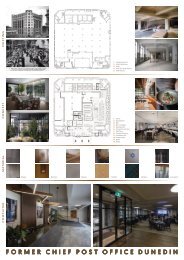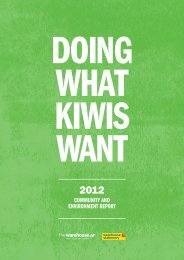ar11-lr-final
Create successful ePaper yourself
Turn your PDF publications into a flip-book with our unique Google optimized e-Paper software.
Notes to and forming part of the Financial Statements – continued<br />
For the 52 WEEK period ended 31 July 2011<br />
Notes to and forming part of the Financial Statements – continued<br />
For the 52 WEEK period ended 31 July 2011<br />
1. Summary Of Accounting Policies (CONTINUED) (f) Income tax<br />
1. Summary Of Accounting Policies (CONTINUED)<br />
(d) Revenue recognition<br />
The income tax expense or revenue for the period is the tax<br />
(k) Trade receivables<br />
Revenue is measured at the fair value of the consideration<br />
payable on the current year’s taxable income based on the<br />
Trade receivables are recognised initially at fair value. Trade<br />
received or receivable. Amounts disclosed as revenue are net of<br />
income tax rate adjusted by changes in deferred tax assets and<br />
receivables arise from sales made to customers on credit or<br />
returns, trade allowances and duties and taxes paid. Revenue is<br />
liabilities attributable to temporary differences between the tax<br />
through the collection of rebates from suppliers not otherwise<br />
recognised for the major business activities as follows:<br />
bases of assets and liabilities and their carrying amounts in the<br />
deducted from suppliers’ payable accounts.<br />
financial statements, and to unused tax losses.<br />
• Retail Sales – Revenue is recognised at the point of sale<br />
Trade receivables are usually due for settlement no more than<br />
Deferred tax assets and liabilities are recognised for temporary<br />
when delivery takes place and the associated risks of<br />
120 days from the date of recognition for intercompany debtors,<br />
differences at the tax rates expected to apply when the assets<br />
ownership have passed to the customer. Products sold<br />
and no more than 60 days for other debtors.<br />
are recovered or liabilities are settled, based on those tax rates<br />
to customers have a right of return and an estimate for<br />
which are enacted or substantively enacted. The relevant tax<br />
Collectability of trade receivables is reviewed on an ongoing<br />
such returns are provided for at the time of sale based on<br />
rates are applied to the cumulative amounts of deductible and<br />
basis. Debts which are known to be uncollectible are written off.<br />
historical return rates.<br />
taxable temporary differences to measure the deferred tax asset<br />
A provision for impaired receivables is established when there is<br />
• Vouchers – Revenue from the sale of vouchers (gift cards, or liability.<br />
objective evidence that the Group will not be able to collect all<br />
refunds and Christmas club) are recognised when the voucher<br />
amounts due according to the original terms of receivables. The<br />
Deferred tax assets are recognised for deductible temporary<br />
is redeemed and the customer purchases goods, or when<br />
amount of the provision is the difference between the asset’s<br />
differences and unused tax losses only if it is probable that<br />
the customer voucher is no longer expected to be redeemed,<br />
carrying amount and the estimated recoverable amount. The<br />
future taxable amounts will be available to utilise those<br />
based on an analysis of historical redemption rates.<br />
amount of the provision is recognised in the income statement.<br />
temporary differences and losses. Deferred tax liabilities<br />
• Lay-by sales – Lay-by sales are recognised when legal title to and assets are not recognised for temporary differences<br />
(l) Leases<br />
the goods passes to the customer.<br />
between the carrying amount and tax bases of investments in<br />
Leases in which a significant portion of the risks and rewards of<br />
subsidiaries and associates where the parent entity is able to<br />
ownership are retained by the lessor are classified as operating<br />
• Interest revenue – Interest revenue is recognised when it is<br />
control the timing of the reversal of the temporary differences<br />
leases. Payments made under operating leases (net of any<br />
earned, using the effective interest method.<br />
and it is probable that the differences will not reverse in the<br />
incentives received from the lessor) are charged to the income<br />
• Dividend income – Dividend income is recognised when the foreseeable future.<br />
statement on a straight-line basis over the period of the lease.<br />
Lease income from operating leases is recognised in income on<br />
dividend is declared.<br />
Current and deferred tax balances attributable to amounts<br />
a straight-line basis over the lease term.<br />
(e) Property, plant and equipment<br />
recognised in equity are similarly recognised in equity.<br />
(m) Intangible assets<br />
Cost<br />
(g) Goods and services tax (“GST”)<br />
Computer software – All costs directly incurred in the purchase<br />
The cost of purchased property, plant and equipment is the The income statement and statement of cash flows have<br />
or development of major computer software or subsequent<br />
value of the consideration given to acquire the assets and been prepared so that all components are stated exclusive of<br />
upgrades and material enhancements, which can be reliably<br />
the value of other directly attributable costs, which have been GST. All items in the balance sheet are stated net of GST with<br />
measured and are not integral to a related asset, are capitalised<br />
incurred in bringing the assets to the location and condition the exception of receivables and payables which include GST<br />
as intangible assets. Direct costs may include internal payroll<br />
necessary for their intended use.<br />
invoiced.<br />
and on-costs for employees directly associated with the project.<br />
Cost may also include transfers from equity of any gains/losses (h) Cash and cash equivalents<br />
Costs incurred on computer software maintenance are expensed<br />
on qualifying cash flow hedges of foreign currency purchases of Cash and cash equivalents includes cash on hand, deposits<br />
to the income statement as they are incurred.<br />
property, plant and equipment.<br />
held at call with financial institutions, other short-term, highly<br />
The cost of self-constructed assets includes the cost of all liquid investments with original maturities of three months or<br />
Computer software is amortised over the period of time during<br />
materials used in construction, direct labour on the project, less that are readily convertible to known amounts of cash and<br />
which the benefits are expected to arise, being two to ten<br />
financing costs, and costs of obtaining regulatory consents that which are subject to an insignificant risk of changes in value,<br />
years. Amortisation commences once the computer software is<br />
are directly attributable to the project.<br />
and bank overdrafts.<br />
available for use.<br />
Costs incurred on repairs and maintenance are charged to the (i) Inventories<br />
(n) Impairment of non-financial assets<br />
income statement during the financial period in which they are Inventories are stated at the lower of cost and net realisable<br />
Assets that are subject to amortisation or depreciation are<br />
incurred.<br />
value. Cost comprises direct purchase cost and an appropriate<br />
reviewed annually for impairment or whenever events or changes<br />
proportion of supply chain variable expenditure. Cost also<br />
in circumstances indicate that the carrying amount of the asset<br />
Depreciation<br />
includes the transfer from equity of any gains or losses on<br />
may not be recoverable.<br />
Property, plant and equipment are depreciated on a straight line<br />
qualifying hedges related to inventories. Costs are assigned to<br />
An impairment loss is recognised for the amount by which the<br />
basis to allocate the cost, less any residual value, over their<br />
individual items of inventory on the basis of weighted average<br />
asset’s carrying amount exceeds its recoverable amount. The<br />
useful life.<br />
costs. Net realisable value is the estimated selling price in the<br />
recoverable amount is the higher of an asset’s fair value less costs<br />
Estimated useful life of property, plant and equipment:<br />
ordinary course of business less the estimated costs necessary<br />
to sell and value in use. For the purposes of assessing impairment,<br />
Freehold land<br />
indefinite<br />
to make the sale.<br />
assets are grouped at the lowest levels for which there are<br />
Freehold buildings<br />
50 to 100 years<br />
(j) Investments in subsidiaries<br />
separately identifiable cash flows (cash generating units).<br />
Store fittings and equipment 4 to 12 years<br />
Investments are stated at the lower of cost or net realisable<br />
(o) Employee benefits<br />
Vehicles<br />
5 to 8 years<br />
value.<br />
(i) Wages and salaries, annual leave and sick leave<br />
Work in progress<br />
not depreciated<br />
Liabilities for wages and salaries, including non-monetary<br />
An asset’s carrying amount is written down immediately to its<br />
recoverable amount if the asset’s carrying amount is greater<br />
than its estimated recoverable amount.<br />
benefits, annual leave and accumulating sick leave expected<br />
to be settled within 12 months of the reporting date are<br />
recognised in provisions in respect of employees’ services up to<br />
the reporting date and are measured at the amounts expected<br />
Gains and losses on disposals are determined by comparing<br />
to be paid when the liabilities are settled. Liabilities for nonaccumulating<br />
sick leave are recognised when the leave is taken<br />
proceeds with the carrying amount. These gains and losses are<br />
included in the income statement.<br />
and measured at the rates paid or payable.<br />
(ii) Long service leave<br />
The liability for long service leave is recognised in the provision<br />
for employee benefits and measured as the present value of<br />
expected future payments to be made in respect of services<br />
provided by employees up to the reporting date. Consideration<br />
is given to expected future wage and salary levels, experience<br />
of employee departures and periods of service. Expected future<br />
payments are discounted using market yields at the reporting date<br />
on New Zealand government bonds with terms to maturity that<br />
match, as closely as possible, the estimated future cash outflows.<br />
(iii) Performance incentive payments<br />
The Group recognises a liability and an expense for performance<br />
incentive payments (bonuses) based on a formula that takes<br />
into consideration individual performance and company<br />
performance linked to the profit attributable to the company’s<br />
shareholders. The Group recognises a provision where<br />
contractually obliged or where there is a past practice that has<br />
created a constructive obligation.<br />
(iv) Equity settled share-based compensation<br />
Equity settled share-based compensation benefits are provided<br />
to employees in accordance with the Group’s employee executive<br />
share rights plan. The fair value of share rights granted under<br />
the plan are recognised as an employee benefit expense with<br />
a corresponding increase in equity. The fair value is measured<br />
at grant date and recognised over the period during which the<br />
employees become unconditionally entitled to the share rights.<br />
The fair value at grant date of the share right’s are<br />
independently determined using an appropriate valuation model<br />
that takes into account the exercise price, the term of the share<br />
right, the vesting and performance criteria, the impact of dilution,<br />
the non-tradeable nature of the share right, the share price at<br />
grant date and expected price volatility of the underlying share,<br />
the expected dividend yield and the risk-free interest rate for the<br />
term of the share right.<br />
At each balance date, the Group revises its estimate of the<br />
number of share rights that are expected to become exercisable.<br />
The employee benefit expense recognised each period takes<br />
into account the most recent estimate.<br />
Upon the vesting of share rights, the balance of the share-based<br />
payments reserve relating to the share rights is netted against<br />
the cost of treasury stock purchased to satisfy the obligation<br />
of settling the share based payment and any residual balance<br />
transferred to retained earnings.<br />
(v) Cash settled share-based payments<br />
The Group introduced a cash settled share-based compensation<br />
plan for holders of ‘performance shares’ (refer note 15) granted<br />
in November 2007.<br />
Cash-settled share-based payments are recognised at the fair<br />
value of the liability incurred and are expensed over the period<br />
of the plan. The liability is remeasured at each balance sheet<br />
date to its fair value, with all changes recognised immediately<br />
as either a profit or a loss. Fair value is determined based on<br />
management’s assessment of achieving the share price targets.<br />
(vi) Employee share purchase plan<br />
The employee share purchase plan provides employees with the<br />
opportunity to acquire shares in the Group. The fair value of shares<br />
granted is recognised as an employee benefit expense with a<br />
corresponding increase in equity. The fair value is measured at<br />
grant date and recognised over the vesting period. The fair value<br />
of the shares granted has been assessed as being equal to the<br />
discount provided to participants when the shares are granted.<br />
FINANCIAL STATEMENTS 36<br />
FINANCIAL STATEMENTS 37
















